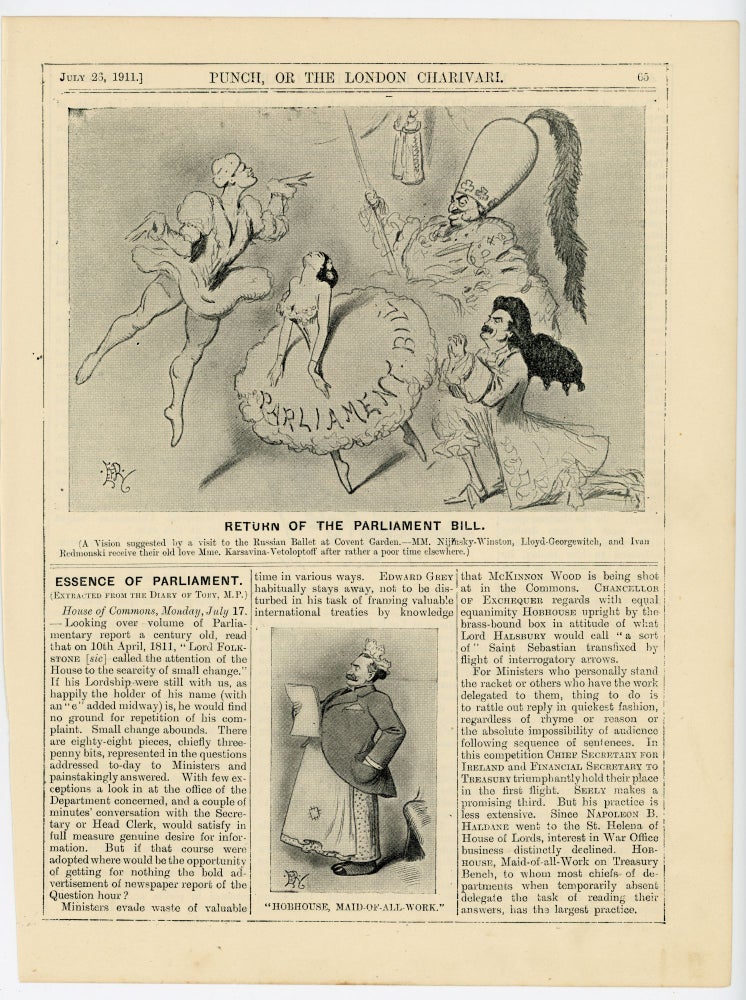RETURN OF THE PARLIAMENT BILL - an original printed appearance of this cartoon featuring Winston S. Churchill from the 26 July 1911 edition of the magazine Punch, or The London Charivari
London: Punch, 1911. This original printed appearance of a Punch cartoon featuring Winston S. Churchill comes from the personal collection of Gary L. Stiles, author of Churchill in Punch (Unicorn Publishing Group, 2022). His book is the first ever effort to definitively catalog, describe, and contextualize all of the many Punch cartoons featuring Churchill.
This cartoon titled "Return of the Parliament Bill.” appeared thus on p.65 of the 26 July 1911 issue of Punch. The artist is Edward Tennyson Reed. The cartoon is captioned "(A Vision suggested by a visit to the Russian Ballet at Covent Garden. - M.M. Nijinsky-Winston, Lloyd-Georgewitch, and Ivan Redmonski receive their old love Mme. Karsavina-Vetoloptoff after rather a poor time elsewhere)."
This cartoon depicts Winston Churchill (as Nijinsky, the greatest male dancer of the early twentieth century), along with David Lloyd George and John Redmond as ballet dancers, approaching the Parliament Bill, repealing the House of Lords veto. The "Mme. Kasavina Vetoloptoff" name is a play on words regarding stopping a veto.
As a young man, the Harrow-educated cartoonist and caricaturist Edward Tennyson Reed (1860-1933) “spent time at the House of Commons sketching politicians in action.” In March 1890 he became a permanent member of the staff of Punch and by 1894 became the illustrator of Punch’s parliamentary pages, a post he held for eighteen years. As this cartoon of Churchill testifies, Reed “had a deft hand at sketching facial attributes amidst often absurd scenes.”(NPG) Reed was popular, not only as a cartoonist, but also as an after-dinner speaker and lecturer. His drawings were published in collections, displayed at exhibitions, and even purchased by King George V. In 1912, Reed left the staff of Punch and subsequently also drew for The Bystander, the Passing Show, the Sunday Times, Pall Mall Gazette, Sunday Evening Telegraph, and the Evening Standard. (ODNB)
Punch or The London Charivari began featuring Churchill cartoons in 1900, when his political career was just beginning. That political career would last two thirds of a century, see him occupy Cabinet office during each of the first six decades of the twentieth century, carry him twice to the premiership and, further still, into the annals of history as a preeminent statesman. And throughout that time, Punch satirized Churchill in cartoons – more than 600 of them, the work of more than 50 different artists.
It was a near-perfect relationship between satirists and subject. That Churchill was distinctive in both persona and physical appearance helped make him easy to caricature. To his persona and appearance he added myriad additional satirical temptations, not just props, like his cigars, siren suits, V-sign, and hats, but also a variety of ancillary avocations and vocations, like polo, painting, brick-laying, and writing. All these were skewered as well.
Some Punch cartoons were laudatory, some critical, and many humorous, like the man himself. Nearly always, Churchill was distinctly recognizable, a larger-than-life character whose presence caricature served only to magnify. Item #007099
Price: $70.00

